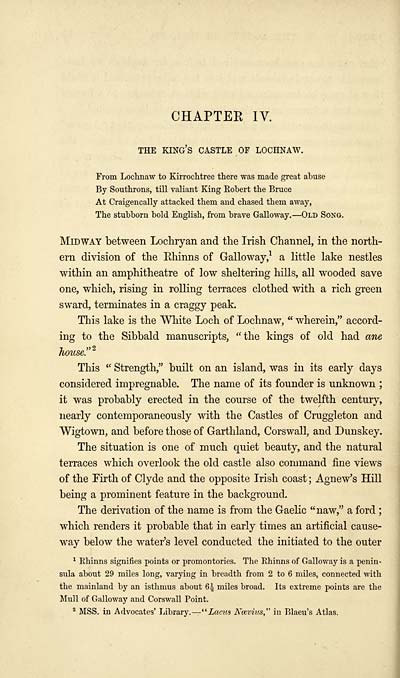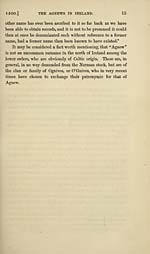Agnews of Lochnaw
(48) Page 16
Download files
Complete book:
Individual page:
Thumbnail gallery: Grid view | List view

CHAPTER IV.
THE KING'S CASTLE OF LOCHNAW.
From Lochnaw to Kirrochtree there was made great abuse
By Southrons, till valiant King Robert the Bruce
At Craigencally attacked them and chased them away,
The stubborn bold English, from brave Galloway. — Old Song.
Midway between Lochryan and the Irish Channel, in the north-
ern division of the Ehinns of Galloway, 1 a little lake nestles
within an amphitheatre of low sheltering hills, all wooded save
one, which, rising in rolling terraces clothed with a rich green
sward, terminates in a craggy peak.
This lake is the White Loch of Lochnaw, " wherein," accord-
ing to the Sibbald manuscripts, "the kings of old had ane
house." 2
This " Strength," built on an island, was in its early days
considered impregnable. The name of its founder is unknown ;
it was probably erected in the course of the twelfth century,
nearly contemporaneously with the Castles of Cruggleton and
Wigtown, and before those of Garthland, Corswall, and Dunskey.
The situation is one of much quiet beauty, and the natural
terraces which overlook the old castle also command fine views
of the Firth of Clyde and the opposite Irish coast ; Agnew's Hill
being a prominent feature in the background.
The derivation of the name is from the Gaelic "naw," a ford ;
which renders it probable that in early times an artificial cause-
way below the water's level conducted the initiated to the outer
1 Ehinns signifies points or promontories. The Rhinns of Galloway is a penin-
sula about 29 miles long, varying in breadth from 2 to 6 miles, connected with
the mainland by an isthmus about %\ miles broad. Its extreme points are the
Mull of Galloway and Corswall Point.
2 MSS. in Advocates' Library. — "Lams Ncevius," in Blaeu's Atlas.
THE KING'S CASTLE OF LOCHNAW.
From Lochnaw to Kirrochtree there was made great abuse
By Southrons, till valiant King Robert the Bruce
At Craigencally attacked them and chased them away,
The stubborn bold English, from brave Galloway. — Old Song.
Midway between Lochryan and the Irish Channel, in the north-
ern division of the Ehinns of Galloway, 1 a little lake nestles
within an amphitheatre of low sheltering hills, all wooded save
one, which, rising in rolling terraces clothed with a rich green
sward, terminates in a craggy peak.
This lake is the White Loch of Lochnaw, " wherein," accord-
ing to the Sibbald manuscripts, "the kings of old had ane
house." 2
This " Strength," built on an island, was in its early days
considered impregnable. The name of its founder is unknown ;
it was probably erected in the course of the twelfth century,
nearly contemporaneously with the Castles of Cruggleton and
Wigtown, and before those of Garthland, Corswall, and Dunskey.
The situation is one of much quiet beauty, and the natural
terraces which overlook the old castle also command fine views
of the Firth of Clyde and the opposite Irish coast ; Agnew's Hill
being a prominent feature in the background.
The derivation of the name is from the Gaelic "naw," a ford ;
which renders it probable that in early times an artificial cause-
way below the water's level conducted the initiated to the outer
1 Ehinns signifies points or promontories. The Rhinns of Galloway is a penin-
sula about 29 miles long, varying in breadth from 2 to 6 miles, connected with
the mainland by an isthmus about %\ miles broad. Its extreme points are the
Mull of Galloway and Corswall Point.
2 MSS. in Advocates' Library. — "Lams Ncevius," in Blaeu's Atlas.
Set display mode to:
![]() Universal Viewer |
Universal Viewer | ![]() Mirador |
Large image | Transcription
Mirador |
Large image | Transcription
Images and transcriptions on this page, including medium image downloads, may be used under the Creative Commons Attribution 4.0 International Licence unless otherwise stated. ![]()
| Histories of Scottish families > Agnews of Lochnaw > (48) Page 16 |
|---|
| Permanent URL | https://digital.nls.uk/94898690 |
|---|
| Description | A selection of almost 400 printed items relating to the history of Scottish families, mostly dating from the 19th and early 20th centuries. Includes memoirs, genealogies and clan histories, with a few produced by emigrant families. The earliest family history goes back to AD 916. |
|---|

